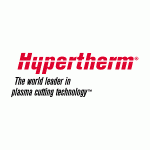NEW INNOVATIONS IN PLASMA CUTTING
Paula Flanders of Hypertherm explains how new materials and torch shapes are increasing the range of plasma cutting applications.
Posted: April 25, 2011
They knew they wanted to stick with plastic because it is light and easily molded, but they weren’t sure exactly which plastic they would use. With hundreds of different brands and compositions to choose from, the task of narrowing down the choices wouldn’t be easy. One thing that helped was the decision to turn to quantifiable measures, like the standards set by the American Society for Testing and Materials for heat deflection, impact resistance and environmental friendliness. Based on that, the team was able to zero in on several different plastics, which had the best balance of properties. Those choices were then evaluated on actual performance, before a winning plastic was selected.
“The challenge with designing plasma torches is that we are cutting metal with a plastic object,” said Jesse Roberts, one of the engineers on the project. “Ideally, the torch handle should be made of brick and rubber at the same time. A brick to take the heat, and rubber to take the day-to-day abuse.”
With a material settled on and the durability objective met, the next challenge was to create a torch better shaped for gouging and cutting in tight places. Oxyfuel users have long had an array of torch angles and lengths available to them. With plasma, though, the shape has traditionally been limited by the need for an internal plunger to bring the electrode in contact with the nozzle and start the arc. The plunger, and wires attached to it, needed room to move within the torch shell, restricting the choice of shapes and angles available to the engineers, and therefore limiting plasma’s usefulness for certain applications.
The solution was to work from the inside out. The engineers knew they had to figure out how to remove the plunger before they could even begin to think about making a meaningful change to the torch’s shape. More months of work followed until the team agreed upon a solution: an entirely new consumable design that replaced the plunger in the torch with a blowback spring in the electrode.
This breakthrough technology, dubbed Spring Start™, is what enabled the engineers to design a nearly straight torch that angles down just 15 deg at the tip. Additionally, this allowed engineers to narrow the neck of the standard hand torch for greater visibility and to change the shape so that it could be held at either a 75 deg or 90 deg angle to the plate.
Now that the team had successfully met their first two challenges (create the most robust torch on the market, and design a torch better shaped for gouging and cutting in tight places), they turned their attention to the third objective. That objective – to provide mechanized plasma users with the same level of innovation and flexibility that handheld plasma users now had – was driven by observations during end user visits.
During those visits, the team noticed that the standard length mechanized torch was often cumbersome for pipe cutting and robotic applications. Their solution was to replace the one-piece mechanized barrel with a modular design that could easily and quickly convert from a long torch to a short one. Users could either work with the standard 15 in torch or remove a section from the barrel to create a 6 in mini torch, better suited for robotic applications, pipe saddles, track burners, and other applications where the extra barrel length was a problem.
So far, the new torches, which arrived on the market late in 2010, are getting rave reviews. Plasma users report the straighter profile of the 15 deg torch makes cuts in corners, overhead, and in tight spots much easier. And for plasma gouging, it is truly revolutionary . . . providing the user with more visibility and better control of the arc while keeping the operator’s hand away from the high heat generated by the gouging process.
As Roberts notes, “a fundamental change had to take place in order to advance plasma torches to the next level of reliability and versatility.” And this change is just one step on the evolutionary process. As operators find new uses for plasma cutting and gouging, plasma engineers will keep innovating right along with them.




